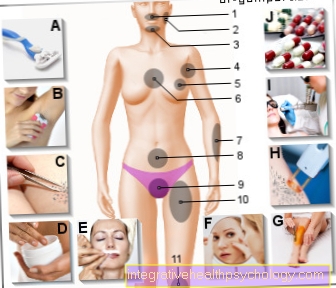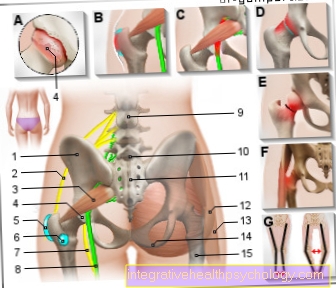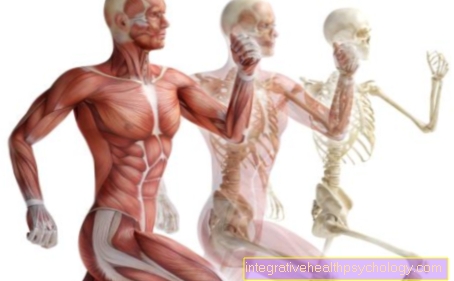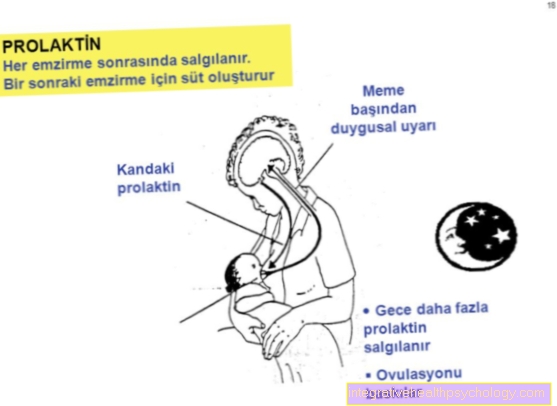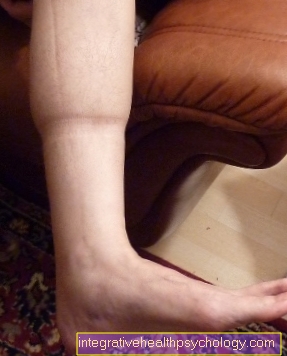Malignant hyperthermia
Synonyms
- Malignant hyperpyrexia,
- MH crisis
English: malignant hyperthermia
introduction
The full picture of malignant hyperthermia is a very serious metabolic imbalance that occurs almost exclusively in connection with anesthesia. In everyday life, a symptom-free, disposition-related disorder in the calcium balance of the muscle cell after contact with certain anesthetic drugs leads to a massive disruption of the overall metabolism with cardiac arrhythmias, oxygen deficiency, hyperacidity and massive overheating of the body. As a result, coagulation disorders, muscle damage, overhydration of the lungs, kidney failure and damage to the brain and nervous system can occur and threaten the patient's life. If left untreated, such a malignant-hyperthermia crisis is fatal in 70-80% of cases, and through consistent and early therapy, mortality could be reduced to below 5%. It is important to document a crisis that has occurred in order to be able to use other anesthetics for later operations that are not a trigger for malignant hyperthermia.
Also read: General anesthetic side effects

Definition of malignant hyperthermia
Malignant hyperthermia is a massive metabolic disorder in which the body's energy, oxygen and acid-base balance is derailed in patients with this predisposition through contact with certain medications during anesthesia.
Epidemiology
The incidence of a predisposition to malignant hyperthermia is estimated to be around 1 / 10,000 in the population. The full picture of the disease occurs in one in 250,000 to 500,000 anesthesia, suspected cases occur in about 1 / 30,000 anesthesia. Younger men are more often affected overall.
Causes of Malignant Hyperthermia
Malignant hyperthermia is a not yet fully researched disruption of the calcium balance of the muscle cells, which remains symptom-free in everyday life.
Contact with certain triggers, v. a. Gaseous anesthetics and drugs that relax the muscles during anesthesia lead to an acutely occurring dysregulation of the calcium balance of the muscle cells, which leads to the inside of the cells being flooded with calcium.
This initiates highly energy-intensive processes in the muscles, which have far-reaching consequences for the entire organism through the consumption of energy carriers, oxygen and the resulting breakdown products: Oxygen and energy carriers that are consumed in the muscles are no longer available to other organs, due to oxygen debt and Decomposition products over-acidify the body, breathing and mineral balance of the body derail and the body temperature rises sharply, whereby the control circuits of the organism are additionally disrupted and trigger malignant hyperthermia.
What are trigger substances?
The trigger substances of malignant hyperthermia, i.e. substances that can trigger this functional disorder, are: inhalation anesthetics, succinylcholine and caffeine. Inhalation anesthetics, e.g. Sevoflurane, are used to induce and maintain anesthesia. An exception is nitrous oxide, which is a safe substance and not a trigger for malignant hyperthermia. Succinylcholine is a depolarizing muscle relaxant that is used in some cases during anesthesia and is the most important trigger substance. Stress can also be a trigger.
Neostigmine
Neostigmine is a Cholinesterase inhibitors. It prevents the breakdown of acetylcholine in the synaptic cleft by the enzyme acetylcholinesterase. This effect makes it suitable as an antagonist of non-depolarizing muscle relaxants, which are used to induce and maintain anesthesia. Neostigmine is e.g. Used when escaping from anesthesia or to counteract the muscle weakness myasthenia gravis. Since non-depolarizing muscle relaxants, in contrast to depolarizing agents such as succinylcholine, are not trigger substances for malignant hyperthermia, neostigmine is not used here.
Symptoms of Malignant Hyperthermia
Early but unspecific signs of the onset of malignant hyperthermia are cardiac arrhythmias during anesthesia. An increased carbon dioxide content can be measured in the exhaled air of the patient, and muscle stiffness occurs over time (Rigor) all over the body. Blood pressure falls with increasing heart rate, and the patient's circulation becomes destabilized. A strong increase in body temperature only occurs relatively late.
In the further course of the malignant hyperthermia, the cell death in the crisis-ridden muscles leads to a potassium overload in the blood, which can lead to cardiac arrhythmias, the oxygen debt in the body and insufficient breathing lead to hyperacidity. Complications can include kidney failure, respiratory failure, cardiovascular failure or brain swelling.
Diagnosis
Patients under anesthesia are extensively monitored using instruments ("monitoring“), Anesthetists are very attentive to malignant hyperthermia. An early sign of malignant hyperthermia is the increasing carbon dioxide content in the exhaled air; signs of over-acidification can be detected in the blood gas analysis. If a malignant-hyperthermia crisis is suspected, immediate action and diagnostics are essential.
In order to clarify a predisposition to malignant hyperthermia in advance of an operation, the only specific option currently exists to examine a muscle sample taken in the laboratory. However, since this requires a small operation (Muscle biopsy) is necessary, this method is not suitable for comprehensive testing / diagnostics.
therapy
The immediate stopping of the supply of the triggering substance and of the greatest importance for the therapy possibly. the change to another anesthetic procedure.
The disease mechanism can be interrupted by administering the drug dantrolene. An operation that is already in progress should be ended as soon as possible. The oxygen supply is increased, if necessary, the acidification of the body and cardiac arrhythmias can be treated with medication. Through consistent, early therapeutic action, the mortality rate in the malignant-hyperthermia crisis can be reduced to almost zero.
forecast
Malignant hyperthermia is a serious, potentially life-threatening incident under anesthesia. However, through clinical experience in dealing with MH patients, the possibility of performing trigger-free anesthesia if a predisposition to malignant hyperthermia is suspected, resolute therapeutic action and the improvement of monitoring and intensive care options, it has been possible to drastically increase the untreated high mortality rate to reduce.
If a patient suspects malignant hyperthermia in the course of previous operations, this must be well documented and the patient informed about this so that he can inform the anesthetist when planning future operations.
The consequences of malignant hyperthermia (such as metabolic imbalance, cardiac arrhythmias, overheating of the body) arise primarily from the administration of so-called trigger substances (anesthetics) during an operation. Therefore, in the therapy of malignant hyperthermia, the immediate discontinuation of the trigger substance is the first priority in order to avoid further damage. Since malignant hyperthermia mainly results in an increased release of calcium, this must be stopped as quickly as possible. If the first signs of a derailment occur during an operation (cardiac arrhythmia, over-acidification of the body), immediate treatment of malignant hyperthermia with muscle relaxants (especially dantrolene) is crucial. These agents block calcium channels, preventing too much calcium from entering the cell. This minimizes the metabolic derailment and the cramping of the muscles. In addition, the enormous increase in heat is prevented.
It is now mandatory in German operating theaters to have such a remedy within reach, as immediate administration is of crucial importance for the treatment of malignant hyperthermia. In recent years, this has resulted in fewer and fewer people having to die from malignant hyperthermia. Nevertheless, if you have a genetic disposition, you should avoid the administration of “classic trigger substances” (anesthetics) so that malignant hyperthermia cannot develop in the first place. It is therefore advisable to undergo a test if there is a known illness in the family to determine whether there is a risk of surgery. If there is a risk of malignant hyperthermia, no trigger substances are used during the operation. Instead, means are used for so-called total intravenous anesthesia (TIVA). Here, nitrous oxide or non-depolarizing muscle relaxants can be used as anesthetics. The aim is to continuously inject sleeping pills such as propofol and pain relievers (such as opiates) into the patient during the operation. This guarantees freedom from pain and unconsciousness during the entire operation without using a trigger substance. Thus, there is no increased risk of operations for patients with malignant hyperthermia as long as they are not operated with trigger substances as anesthetics.
Despite the immediate administration of muscle relaxants such as dantrolene, there is an (albeit less) derailment of the metabolism. This includes, among other things, acidification of the body (Acidosis) as well as an increased concentration of carbon dioxide (CO2) in the blood. Since both are harmful to the body, inhalation with 100% oxygen is used for the therapy of malignant hyperthermia and the patient is allowed to breathe more via the ventilator so that more CO2 is exhaled and more O2 is available to the body at the same time. This works against a lack of oxygen (Hypoxia) opposite. The acidification of the body is caused by the infection of an alkaline agent (for example Sodium bicarbonate) counteracted.
In order to avoid a disruption of the blood coagulation, one also frequently uses for the therapy of malignant hyperthermia Heparin. This remedy ensures that the blood cannot clot completely. Thus, the blood does not clump, but remains liquid. This is especially important to one Thrombus formation prevent and a possible embolism to avoid. The kidney function is also at risk from malignant hyperthermia. The most important thing here is that Crush syndrome to avoid. In crush syndrome, it occurs due to an increased attack of Myoglobin to a Renal failure. Myoglobin is increasingly released from damaged muscles, among other things. As a therapy for malignant hyperthermia, the administration of urinary drugs (Diuretic) important. During the metabolic derailment in malignant hyperthermia, the body also builds up more heat. In order to minimize this, the body is slightly cooled down (for example with cool towels). Since cardiac arrhythmias occur during the operation (especially increased heartbeat), monitoring of cardiac activity and blood pressure is another therapeutic measure. Patients are often transferred to the intensive care unit for this.








